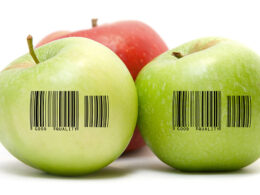Barcode Inspection: What, Why and How
Barcodes are now an essential element mandated by worldwide manufacturers and regulatory agencies. The use of barcodes has become so pervasive that ISO standards provide detailed criteria for “grading” a barcode’s readability. Suppliers face significant fines, audits, return of goods, or hefty chargeback penalties for failing to produce barcodes above the minimum requirements established by the customer or regulatory agency. Checking the barcode quality before shipment is prudent as it can prevent penalties, fines, returned goods, impact to reputation, audits, and chargebacks. Barcode verification can yield attractive returns for the investment made.
What Can Possibly Go Wrong With a Simple Barcode?
With such a wonderfully simple architecture, what could possibly go wrong to render a barcode unreadable? Barcodes rely on the point being inspected as being either “light” or “dark.” What if the ribbon has a flaw or a wrinkle, the inkjet nozzle doesn’t fire correctly, or the print density was set incorrectly, and a poor quality dot is laid down? Is the dot light? Is it dark? Or possibly indeterminate?
If the paper stock has background colour that reduces the contrast, if there is a smudge or streak in the paper, or if the printer puts down a light dot, there is a chance that the scanner cannot make a clear determination of “light/dark.”
Even with decades of dedicated engineering to reduce variability and eliminate defects, the random dust particle, or a mechanical/electrical glitch will always be a variable impossible to control completely. Said another way, there is a very good chance that some malformed barcodes could be generated in a batch.

And even if the barcode is perfectly formed, it can still fail. To avoid unrelated characters or dots from being interpreted as a barcode, there needs to be a “quiet zone” around the barcode so the interpreter can determine that the dot it is reading is from the barcode and not a text character or a blotch on the paper. Merely placing a perfectly formed barcode in the wrong place – too close to an edge, too close to a line, too close to text – can result in the barcode failing.
It is possible to have an entire article just about the causes of barcode grading failures, but that is outside the scope of this one. Let’s summarize by simply saying that barcodes can and will fail on occasion.
Impact of poor barcodes
Robotics and automated systems are highly dependent on the quality of the incoming barcode to enable them to move incoming pallets to the right location. An unreadable barcode stops the process. Pallets that are unidentified block other incoming pallets, require manual intervention, and gum up the works. The problem is sufficiently acute that many companies that receive high volumes of goods impose penalties to discourage their suppliers from sending in poor quality labels. These penalties may be to reject the shipment, issue a chargeback to the supplier, demand a quality audit at the supplier’s shipping location, or even cancel the supplier contact.

How to Catch Barcode Failure
Obvious failures might be caught by someone looking at the label, but issues with alignment, decodability, axial conformity, modulation, or other defects require a barcode scanner to catch. The question becomes when and where to scan the label.
The choices are either after the label has been applied to the target (could be carton, product, and so on), or before the label has been applied. If the decision is after the label has been applied, there needs to be a way to divert the entire package from the process flow so it can be returned to the label station and have a new label printed and applied. This typically involves linking the scanner to a server that will evaluate the barcode, determine whether the barcode is acceptable, and then having a way for the server to control a switch or other means of flagging a box that needs to be removed from the flow.
Checking the barcodes before the label has been applied has the advantage of removing only the label from the process flow and reprinting the label without the necessity of physically moving the box the label is applied to, potentially minimizing operator intervention or investment in recirculation lines within the conveyor system.
The best approach is to integrate the barcode scanner with the printer so the printer can retract the label, overstrike the failed label, and reprint the label again.

Conclusion
Barcode failure impacts many people downstream and will probably result in that pain being shared with the sender. Barcode inspection offers easy and inexpensive insurance to avoid issues and capture helpful data. Integrating the scanner with the printer provides the most effective solution to minimize cost, space, and labour to provide 100% inspection on every barcode on every label. PrintDATA has been building integrated label inspection systems for over 20 years and has earned the trust of leading companies in Western Australia. For more information about our integrated scanning systems, please contact us here







